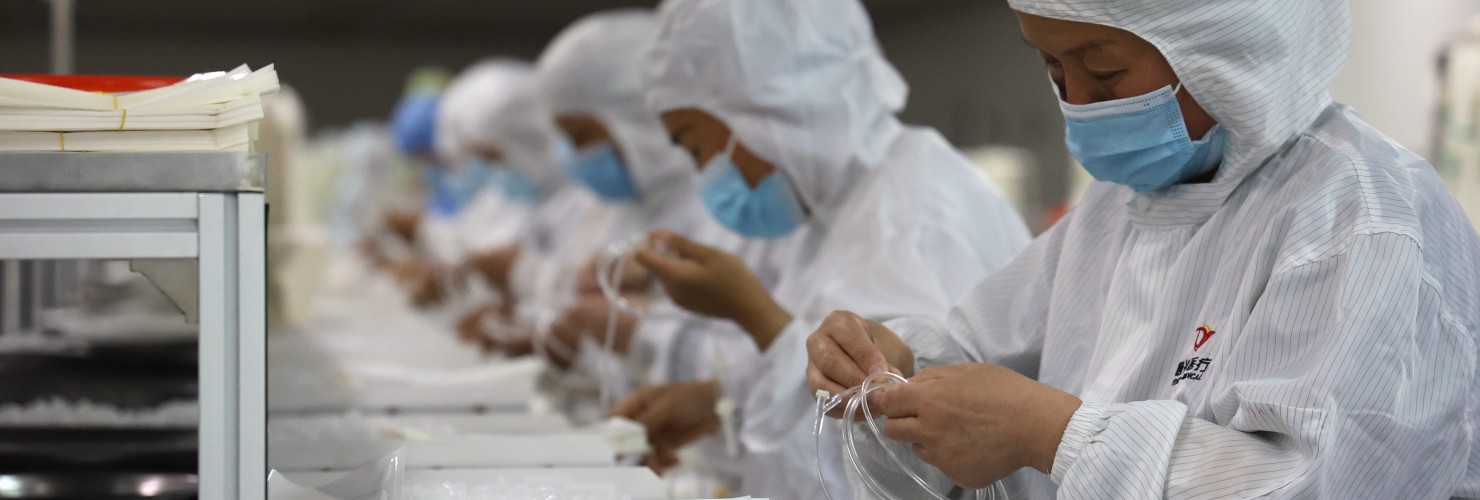

Medical equipment + Cruise ships + Drones
MERICS TOP 5
1. Using central government procurement to support medical equipment manufacturers
At a glance: The Ministry of Industry and Information Technology (MIIT) and the National Health Commission (NHC) have released application requirements for two types of demonstration projects on medical equipment development. The first allows consortia of medical institutes and medical equipment manufacturers to showcase clinical uses of innovative equipment and enjoy priority government procurement. The second encourages local governments to establish demonstration bases.
Successful equipment manufacturers:
- should ensure that the “safe and controllable” (commonly interpreted as domestically produced) proportion of innovative medical equipment products, key materials, or components is above 75 percent
- benefit by being placed on “the major technical equipment promotion and application guidance catalogue” issued by MIIT and used to promote high-tech products through procurement and sales subsidies.
Local governments planning to establish a demonstration base should:
- attract at least 30 companies (including specialized SMEs or “little giant” companies) and medical institutions, one of which must be part of a medical equipment demonstration project
- promote the integration of medical equipment development with digital technologies (e.g., AI, big data or 5G).
MERICS comment: China’s government has longstanding concerns about foreign dependencies in its large and growing medical equipment market. Despite efforts to replace imports, for instance as part of the “Made in China 2025” strategy, China still brings in 70 to 80 percent of high-tech medical equipment from abroad. Policy makers regard this not only as a missed economic opportunity but also as a national security risk.
To break through the technological bottlenecks that lie at the heart of this problem, planners have started to use government procurement to incentivize companies to meet the above-stated requirements to receive state funds, thus strengthening domestic companies in the field. This strategy was first pioneered in the pharma sector. In 2021, for instance, imported products were excluded from government procurement schemes in 137 medical device categories. For others, there are local content requirements. Due to the size of the Chinese market, the strategy seems to be paying off. German medical equipment manufacturer Siemens Healthineers recently called itself a “Chinese company” and announced the localization of high-end equipment. Foreign Companies will be eager to participate in the proposed demonstration projects because it could give them a better shot at securing major procurement contracts.
Article: Administrative Measures for High-end Medical Equipment Application Demonstration Bases (Trial) (高端医疗装备应用示范基地管理办法(试行)) (Link)
Issuing bodies: MIIT, NHC
Date: July 11, 2022
2. Cruise ships: Setting sights on uncharted shipbuilding capabilities
At a glance: Five government ministries led by the MIIT have issued a circular outlining measures to promote the development of China’s cruise ship and yacht industries. These include boosting manufacturing capabilities, strengthening supply chains, and growing domestic cruise ship and yacht tourism. Among the key targets for 2025 are:
- ensuring that the first domestic large-scale cruise ship is completed and delivered on schedule to high quality standards
- developing the batch production of small cruise ships and the mass production of yachts
- improving the technical level and supply capacity of equipment to essentially cover the needs of the domestic market and meet a proportion of international demand
- deepening international exchanges and researching the inclusion of the cruise, yacht, and equipment industries in the encouraged foreign investment catalogue.
MERICS comment: China’s shipbuilding sector accounted for 46.2 percent of global output in 2021. However, the country’s cruise ship building industry is still in its infancy. The government now wants to move into this high value-added segment.
These ambitions pose a long-term threat to the leading cruise ship and yacht builders in Europe. At the same time, China’s potential as a growth market also provides a strong incentive for foreign companies to gain a foothold. For instance, Italy’s Fincantieri has partnered with the China State Shipbuilding Corporation (CSSC) on the development of cruise ships since 2017. Collaboration with domestic players has emerged as an effective way to tap into the Chinese market. Investment in independent dockyards in China is also technically feasible but difficult due to administrative hurdles.
Given the highly customized nature of cruise ships and yachts compared to standard cargo ships, it is likely that China will attempt to attract foreign shipbuilders and suppliers with the goal of replacing them once domestic alternatives are available. Foreign firms ought to weigh the potential short-term gain of investments into China against the long-term risks and prepare for more competition in the EU and third-country markets.
Article: Implementation Opinions on Accelerating the Development of Cruise and Yacht Equipment and Industry (五部委联合发布《关于加快邮轮游艇装备及产业发展的实施意见》) (Link)
Issuing bodies: MIIT, NDRC, MOF, MOT, MCT
Date: August 18, 2022
3. Drones: Beijing backs its UAV industry to reach new heights
At a glance: The Civil Aviation Administration of China (CAAC) has released a draft roadmap for the development of the civil unmanned aerial vehicle (UAV) – i.e., civilian drone – industry. Beijing plans to build up related infrastructure and enhance the regulatory framework to stimulate innovation in the sector. The roadmap sketches numerous milestones to be achieved by 2035, including:
- the widespread use of UAVs for the short distance shipping of lightweight goods and the trialing of passenger flights for urban commuter transportation by 2025
- the establishment of regional hub airports and hub-and-spoke route networks, as well as platforms to facilitate the integrated management and service of airspace, by 2030
- the use of UAVs for the shipping of packages between cities and the performance of intercity passenger flight trials by 2035.
MERICS comment: China is already a leader in UAV technology. Shenzhen-based DJI remains the world’s top commercial drone manufacturer, accruing 54 percent of global market share in 2021 even after the United States restricted exports to the company by adding it to the Entity List in 2020. Beijing hopes to leverage this strength to take the lead in related industries such as logistics, geographical mapping, and environmental protection, as well as in passenger transport.
We can expect to see the development of a similar pattern to that observed in other emerging technologies such as 5G and AI, where authorities direct substantial resources to promising firms and applications. Numerous Chinese logistics companies including JD.com, SF Express, and Meituan are working on large-scale logistics drones and airway networks. Local governments in Sichuan, Hunan, Hainan, and Jiangxi are preparing low-altitude airspace regulations to support the commercialization of drone applications.
If China can set up a clear regulatory framework and the necessary infrastructure and support systems, it could emerge as a frontrunner within UAV innovation and related standard setting. Government support for the development of these technologies could lead to more foreign firms investing in research and development operations in China. Volkswagen, for instance, has already developed an electric passenger drone prototype in China and begun test flights.
Article: Roadmap for the Development of Civil Unmanned Aviation V1.0 (Draft for comments) (关于对《民用无人驾驶航空发展路线图V1.0》征求意见的通知) (Link)
Issuing body: CAAC
Date: August 22, 2022
4. CAC launches online filing portal for Big Tech algorithms
At a glance: Internet regulator the Cyberspace Administration of China (CAC) has published a list of 30 tech-firm algorithms that have been added to a new public filing system. This marks the first time the Internet Information Service Algorithmic Recommendation Management Provisions, designed to promote transparency, has been enforced since it entered into force in March. The list includes basic information related to the following types of algorithms:
- Personalized targeting, e.g., personalized newsfeeds
- Filtering and searching, e.g., featuring hot topics, identifying illegal content
- Scheduling, e.g., drivers’ schedules and routes
- Generative models, e.g., adding filters to videos.
MERICS comment: The collection of data on algorithms has two goals. Firstly, authorities claim this will help protect consumer and worker rights, which have been abused in the past by tech giants using exploitative algorithms. Secondly, it will help officials assert control over public discourse by ensuring algorithms support Beijing’s censorship and propaganda agenda.
Companies are now required to share the inputs and outputs of their algorithms with the CAC; they do not, however, need to detail the specific algorithm used and how it converts inputs to outputs. Anonymous sources have told The Wall Street Journal that the material shared goes beyond what is publicly available and includes confidential business information, but falls far short of providing codes or data. Yet with neither the codebase nor the data transferred, the CAC has no way of ensuring companies are only using the declared data. It also remains to be seen whether the regulator has the skilled staff needed to review algorithm codes and the functioning of these machine-learning systems. This casts doubt on the efficacy of the regulations.
China’s digital platform market is dominated by domestic players; the rules will therefore mainly apply to Chinese firms. However, any foreign provider of apps or online services using algorithms to curate content must register on the portal and comply with the Provisions. Additionally, as the first jurisdiction in the world trying to regulate companies’ algorithms, China may set a precedent for future regulation elsewhere, possibly also in Europe.
Article: Announcement of the State Internet Information Office on Issuing Internet Information Service Algorithm Filing Information (国家互联网信息办公室关于发布互联网信息服务算法备案信息的公告) (Link)
Issuing body: CAC
Date: August 12, 2022
5. Academic support: Universities to bolster SME R&D efforts
At a glance: Three ministries and government agencies have issued a plan aimed at encouraging collaboration between universities and industry, especially highly specialized SMEs, on core technology research. Key measures include:
- encouraging SMEs to participate in Ministry of Education (MOE)-run engineering research centers and engaging professors and doctoral students as technical mentors and researchers
- subsidizing “little giant” companies to foster university-industry innovation
- matching universities and companies and strengthening financial support for collaborative innovation projects
- evaluating universities and researchers on the basis of their technical consulting services and cooperation projects undertaken with companies.
The Ministry of Education has established more than 300 engineering research centers in universities to align their research with national development targets. These centers receive state funds to become bridges between academia and industry. Their tasks include studying and proposing industrial technical standards, promoting the application of advanced technologies, and providing technical information and consulting services for industry.
MERICS comment: Chinese universities and companies commonly cooperate. Shanghai’s Jiao Tong University, for instance, is working with the CSSC on maritime technologies. Instead of waiting for such collaborations to emerge organically, China’s government is keen to speed things along and guide cooperation projects towards strategic technologies. Authorities regard innovation as a silver bullet to sustain economic growth and are therefore seeking to overcome a perceived lack of collaboration between the academic and corporate worlds.
The plan incentivizes both universities – through evaluation criteria – and specialized SMEs – through subsidies – to cooperate on innovation. Zhengzhou University is proactively spending CNY 10 million to match 100 professors with 100 companies in sectors including new materials and the life sciences. Such state-coordinated collaboration could fast-track China’s indigenous innovation efforts. Companies could increase their competitiveness by gaining valuable insights from state-funded universities.
While foreign companies with leading technological capabilities will always be sought-after partners for Chinese research institutes, the main target group of this policy is Chinese SMEs, not foreign companies. If successful, the policy will boost Chinese innovation capabilities and increase competition for foreign companies in the years ahead.
Article: Notice on “Thousand Schools and Ten Thousand Enterprises” Collaborative Innovation Partnership (组织开展“千校万企”协同创新伙伴行动的通知) (Link)
Issuing bodies: MIIT, MOE, CNIPA
Date: July 11, 2022
NOTEWORTHY
Policy news
- July 7: CAC releases security review measures required for the export of data (CAC notice; MERICS China Essentials article)
- July 7: Shenzhen releases regulations on intelligent connected vehicles outlining China’s first framework for liability in the event of an accident (Shenzhen People’s Congress; Reuters article)
- July 15: MIIT releases evaluation criteria for the fourth round of “little giants”. These include at least three years’ experience in a “crucial part of the supply chain” and over 10 percent domestic market share in their niche (MIIT announcement; South China Morning Post article)
- July 21: CAC fines Didi Global Inc. CNY 8.026 billion for the illegal and excessive collection of user and driver information, among other practices (CAC announcement; MERICS short analysis)
- July 29: Jin Zhuanglong is named party secretary and new minister of MIIT after former minister Xiao Yaqing comes under investigation for “violation of discipline and law” (MIIT announcement; CCDI announcement; Caixin article)
- August 1: MIIT, the National Development and Reform Commission, and the Ministry of Ecology and Environment outline measures to peak emissions in key industries such as iron and steel, petrochemicals, consumer goods, equipment manufacturing, and electronics (MIIT notice; S&P Global article)
- August 8: Five government agencies led by the Ministry of Science and Technology (MOST) launch a special action program to “reduce the burden” on young researchers (MOST notice)
- August 12: MOST and other government agencies issue guidelines on how to accelerate innovative applications of AI technologies in areas including robot-assisted manufacturing and industrial machine vision inspection (MOST notice)
- August 15: MOST and the Ministry of Finance publish an action plan to improve the technological innovation capacity of firms in 2022 and 2023, promising preferential tax policies (MOST notice)
- August 18: MOST issues a plan for science and technology to support decarbonization during the period 2022-2030, promoting low-carbon transition technologies, industrial processes, etc. (MOST notice)
- August 25: MIIT releases a draft policy to support the battery industry, calling for breakthroughs in key technologies such as ultra-long-life and high-safety battery systems, as well as large-scale, high-efficiency energy storage (MIIT notice)
Corporate news
- July 18: Stellantis and Chinese state-owned carmaker GAC end their joint venture after the former failed to secure a 75 percent equity stake (Stellantis press release)
- July 19: Researchers at Canadian tech analysis firm TechInsights believe that Chinese chip maker SMIC may have the ability to produce 7-nanometer fabs (Tech Insights blog)
- July 26: Fosun Pharma and Genuine Biotech win the right to market the first China-made oral Covid-19 drug (Sohu article)
- July 26: The Shanghai Data Exchange forms partnerships with 12 banks and digital economy-related companies, to work on data sharing, transactions, and related standards (Yicai article)
- July 29: British energy company Shell and Shanghai Shenergy Innovation and Development announce they have formed a joint venture to build hydrogen refueling stations in Shanghai (Shell press release)
- August 3: China completes the development of a BeiDou short-message chip for smartphones, allowing users to communicate in situations where no other signal is available, such as during emergencies or offshore fishing (Caixin article)
- August 16: Swedish clothing retailer H&M returns to Chinese E-Commerce platform Tmall after its removal a year earlier due to a wider boycott related to the firm’s stance on Xinjiang cotton (Reuters article)
- August 17: Chinese car- and battery maker BYD announces USD 4.2 billion investment plans for a lithium and battery project in Jiangxi province (Caixin article)
- August 23: Shipbuilder CSSC announces plans to consolidate its diesel engine operations to reduce internal competition and improve bargaining leverage for nautical power systems (Caixin article)
- August 26: SMIC reveals plans to invest USD 7.5 billion in the construction of a new factory in Tianjin to produce 12-inch silicon wafers at a rate of 100,000 pieces per month (Nikkei Asia article)



